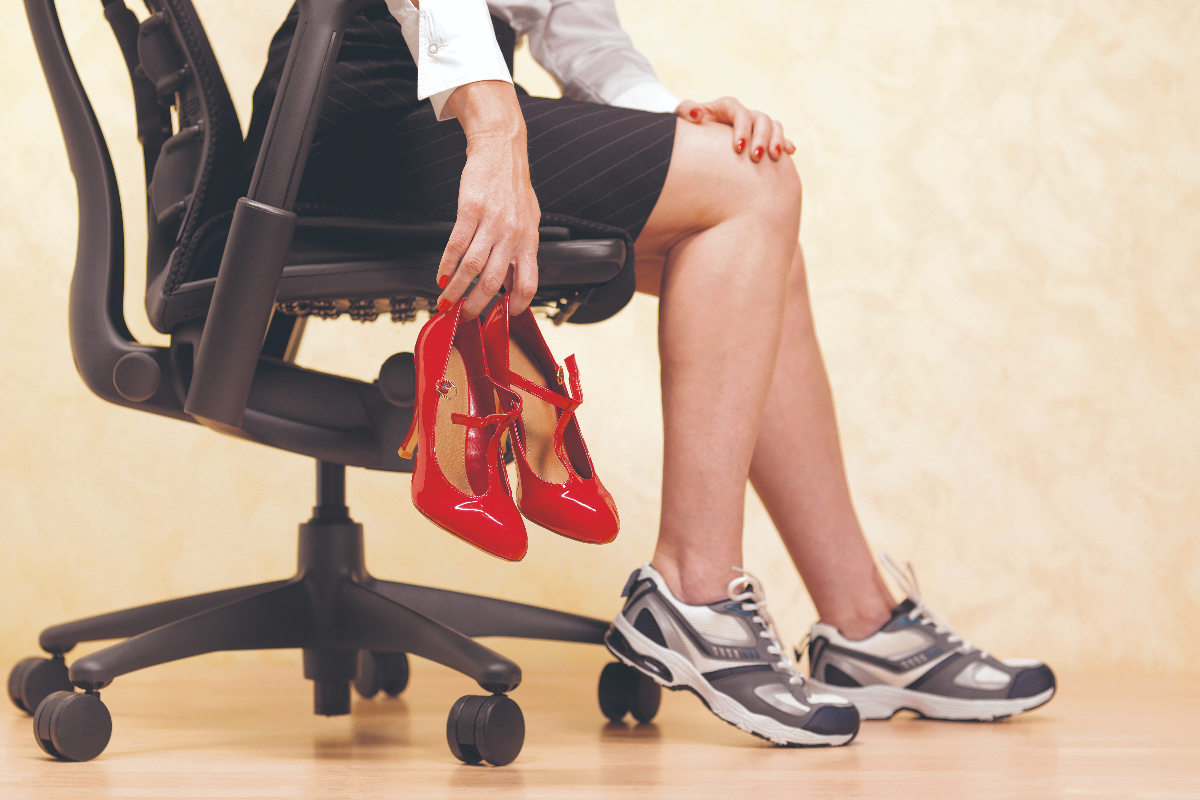By Eliza Filby,Margaret Thatcher. Her
Copyright cityam

There’s been a quiet revolution in corporate fashion, with the post-Covid workforce ditching stilettos for sneakers. For the Autumn edition of City AM The Magazine, Dr Eliza Filby surveys the footwear landscape
Back in the 1990s, the image of a corporate woman rushing to the office with trainers hastily slipped over tights – formal footwear stashed in a bag or left under a desk – was ubiquitous from Canary Wharf to Kuala Lumpur. But like cash payments and regular trips to the cinema, the pandemic put paid to that.
Our new era of hybrid working has meant many of us are no longer in the office as much, and if we are, we’re not in so much of a hurry. The trend of wearing trainers over tights has a traceable cultural origin: Melanie Griffith in the first iconic movie to celebrate corporate feminism, Working Girl. Released in 1988, it was all power suits and trainers, questioning how far women should and could contort themselves to make it in a working world designed by and for men. Trainers over heels embodied the workplace contradiction for that generation of women: the blurring of old and new feminine standards, the modern requirement to be both efficient and elegant, productive and polished.
Over the last 30 years, we have witnessed the casualisation of office attire and, more specifically, the decline of the heel. Trainers began outselling high heels in the UK somewhere between 2015 and 2017, a quiet but telling cultural inflexion point. Women aged 35 to 44 (Millennials and, increasingly, Gen X) have become the main trainer buyers, proving the trend is no longer limited to younger consumers.
The new face of female corporate fashion: hybrid working and looser dress codes shifted the dial
Hybrid working, looser dress codes and the pandemic all accelerated the shift. But this isn’t a story about fabric, fashion or footwear – it’s about power. The slow retreat of the heel reflects the gradual empowerment of women in the workplace, and a rejection of the discomfort once demanded as the price of looking “professional” for the male gaze.
As someone who spends a lot of time in corporate spaces, I can say with confidence that in 2025 the towering arc of a stiletto is a rare sight. A wedge is common, a stacked trainer even more so. A smart flat is very now. A croc is entirely possible. Millennials and Gen Z have chosen practicality and comfort, and their Gen X leaders have embraced these trends with relief and gusto; even the grand dames of the corporate world, the Baby Boomers, feel they no longer require such elevation. So how did we get here?
1960s/1970sWe often assume the mini skirt of the 1960s was the first true act of clothing rebellion. Yet for feminist icon Gloria Steinem, the critical rupture came in the 1970s with the rejection of the midi skirt. That, she argued, was the moment women finally began to shed workplace dress codes and dress for themselves. “When we were told to give up our miniskirts for midis,” she remembered, “there was a semi-conscious boycott on the part of American women. We were fed up with being manipulated. We now wanted to make our own decisions on hundreds of things, not have them handed down from on high.”
The feminist movement naturally found expression in fashion: the rejection of corsets, even bras, the switch to formless dresses or dungarees; women found their freedom in a looser, more masculine silhouette. This was not lost on observers. “Every time I see a girl in slacks,” President Richard Nixon informed White House journalist Helen Thomas in 1973, “it reminds me of China.” It’s a comment that demonstrated how the private fashion choices of women had become political.
But fashion history never moves in a straight line. Trends rise and fall, reflecting culture itself, in waves of liberation and backlash. The trouser suits of the 1970s (remember the iconic image of Bianca Jagger gliding into Studio 54 in her white YSL suit?) were a modern, sexier, flared reimagining of Katharine Hepburn from the 1930s. In the 1970s came the conservative recoil: out went the dungarees, in came pussy-bow blouses and, eventually, Laura Ashley floral dresses.
1980s/1990sBy the 1980s, women’s clothing had become even more overtly political, embodied most of all by Margaret Thatcher. Her style went on a journey: first, blouses and skirts as she talked groceries and housewife economics, then full-on power-suits when taking on the USSR or saying “No. No. No” to the Europeans. The fashion of 1980s corporate feminism encouraged the then-growing number of women entering the workplace to imitate men, to literally broaden their frame with shoulder pads, to appear larger, with straight-line trousers to echo the male silhouette.
But wasn’t this still a kind of conformity? To operate in the same spaces as men, you had to dress like them. Was it a submission, too, to the male sadomasochistic fantasy of the ‘dominant’ woman? Thatcher herself was notoriously reluctant to promote other women, deriving much of her power from being the only female voice at the all-male cabinet table. And she was hardly unique. Many of the corporate women elevated in the 1980s and 1990s built their authority on similar terms, rising precisely by mimicking rather than challenging masculine codes of dress and codes of power (this still continues and, frankly, it’s not talked about enough).
1990s/2000sThe 1990s ushered in a profound shift, both in the workplace and in what women wore there. For the first time, Gen X women began to outnumber men at university, and that educational milestone carried into the professional sphere. With more women entering the workforce came two key changes: greater disposable income and, crucially, a more feminised office culture.
Women’s corporate fashion wardrobes began to reflect this evolution. The hard-edged power suit of the 1980s softened into something more minimalist, even preppy. Workwear demonstrated greater freedom and self-expression; women no longer had to ape men to be taken seriously. Moreover, the rise of a gender-neutral “business casual” – accelerated by US tech culture and tech itself – blurred the boundary between the office and the outside world.
The 1990s and early noughties were less about women storming the gates of the corporate world in armour and more about reshaping the office in their own image, even if that image remained dominated by traditional gender dynamics (and was often policed in subtler ways). What woman didn’t want to become a lawyer after watching Ally McBeal?
But then the kids of the 1980s and 90s, the millennials, who had grown up with US sports-casual sneaker culture and Spice Girls feminism, entered the workplace. The 21st century became a strange contradiction: a revival of formality and a creeping casualisation of office life.
The rise of Silicon Valley chic – hoodies, jeans and trainers – seeped into the corporate world, eroding once-rigid codes of officewear. By the 2010s, “dress-down Friday” was a permanent fixture, as was the laptop, further blurring the professional and the personal.
2010sIf Sex and the City had set the standard for aspirational glamour in the late 1990s, Girls arrived as its millennial antidote. Out went Carrie in her Manolos, in came Hannah Horvath in all her social awkwardness and ill-fitting garb. Girls was deliberately anti-SATC, reflecting both the financial struggles of millennials coming of age in the aftermath of the Financial Crisis, but also the ‘me, me, me’ generation’s desire for careers and clothes to embody their purpose, identity and selfhood.On the other hand, the 2010s also saw Mad Men nostalgia sweep through popular culture. Men embraced their inner Don Draper with sharp suits, while women channelled Joan Holloway with pencil skirts, cinched waists and a resurgence of figure-hugging dresses. Princess Kate amplified this look, her fitted dresses and nude heels offering a reassuringly traditional mode of feminine dress: polished, middle-class, in control.
This was the dichotomy of the 2010s: Hannah Horvath vs Kate Middleton, the polished vs the unpolished. The forces of economics seemed to favour the latter. Women battled stagnant wages, digital overload, dual-income pressures and the relentless, pointless demand to ‘lean in’.No wonder then that there was outrage when, in 2016, Nicola Thorp, a temporary receptionist at PwC, was sent home for refusing to wear high heels, as demanded by her agency Portico. The story went viral, sparking a parliamentary inquiry and a petition signed by more than 150,000 people. It revealed just how out of step corporate dress codes had become. By then, millennial women entering their thirties had already established their unofficial uniform: the floral dress and trainers combo. The heel was not just unfashionable: it was extinct.
2020s?The 2020s will be remembered as the decade when office fashion came undone. Covid didn’t just mean closed offices, it signalled the end of a certain type of all-consuming work culture that defined the late 20th and early 21st century. That previous era demanded constant presence, endless productivity and a uniform of conformity.
The pandemic broke that spell. Overnight, traditional workwear felt uncomfortable, unnecessary and out of vogue. Unsurprisingly, sales of heels fell 65 per cent in the second quarter of 2020. Dry cleaners began to disappear from high streets. Soon the cost of a man’s suit was no longer being used as an official measure of inflation. Mandatory work from home (WFH) orders forced us to rethink not only our wardrobes (and all those ‘dry clean only’ garments) but also our deeper priorities around work, life, health and family.
Emerging out of our Covid bunkers, we found ourselves tentatively in a new, uncertain corporate world. If bosses had issued a blunt, five-days-back edict when restrictions lifted in 2021, perhaps things would have snapped back. Instead, the return to office happened in drip, drip, drip increments: first two days, then three. For many professionals, the creep is now toward four. The flexibility in our work schedule was mirrored in our wardrobes. We permanently loosened waistbands, we over-purchased Zoom-friendly accessories, we blurred the boundary between workwear and workout wear.
The fashion industry, always quick to reflect cultural shifts, leaned in. The telling trend of the hybrid moment? The rise of the luxury trainer. No longer confined to Nike or Reebok, they appeared more and more on Russell & Bromley shelves and Dolce & Gabbana catwalks. Comfort, glamour and cost went hand in hand; luxury trainers became the new handbags.
Hybrid clothing was shaped not just by location, but also shifting attitudes to work itself. The career woman was no longer glamourised or romanticised, rather the attitude was: ‘More fool you girl, you can’t have it all, and you’ll just burn out trying’. Online trends like “lazy girl jobs” and “quiet quitting” pushed life satisfaction to the forefront, replacing old “girlboss” aspirations. Fashion followed suit: athleisure became the uniform for a generation that moved fluidly from 9–5 to 5–9, from Zoom meetings to Pilates classes.
But this took on a particular edge for Gen Z. WFH and then hybrid working was an expectation for a generation that had entered the workforce during a pandemic. Their scepticism also came from having grown up watching dual-income parents return home exhausted by digitalisation and an always-on work culture, as well as their own initiation into office life, which was staring at the green dot of a laptop camera for eight hours a day.
No wonder the humble, bendy, washable Croc became their fashion symbol. It’s a shoe with no structure, no support, but also no constraints, a semi-knowing critique of late-stage capitalism. In China, Gen Z became known as the ‘lying flat’ generation, describing the young people ‘opting out’ of the hyper-competitive work culture known as ‘996’ (9am-9pm, six days a week). It just seemed so… exhausting.
This is a generation whose careers had been derailed by Covid, whose very existence felt digitised and dehumanised, whose economy was defined by stagnant wages, rising costs and the looming shadow of AI. Why would they physically contort themselves (or squeeze their feet) into a system that offers so little certainty and so few rewards?
If economics reshaped how we thought about – and dressed for – work, so did politics. Pre-Covid, the MeToo movement had forced a reckoning with workplace power structures, from Hollywood to corporate boardrooms (with varying degrees of success, of course). It also pushed out into the open how those structures enabled abuse. In its wake, greater DEI initiatives – however performative – gave women more freedom (and, one would hope, more acceptance) to wear their identities at work. It opened the door to sartorial self-expression beyond Western norms, whether that meant a hijab, natural Afro hair or a sari. These are small but powerful signals that ‘professional dress’ in the corporate fashion world no longer had a single definition.
Technology, meanwhile, enabled fashion to become more bespoke (personalised trainers, anyone?) – a phenomenon entirely befitting of the algorithmic age.
Tiktok trends also started to dictate corporate fashion. The ‘Office Siren’ trend, which peaked on Tiktok in 2024, turned office culture into costume or, as the platform would have it, #corporatecosplay. This short-term trend saw workwear reimagined as dress-up, with viral videos such as ‘my short skirt got me the sack’ prompting bemused but sincere Gen X HR managers to make explainer videos on what was appropriate officewear. The trend spoke to a generation for whom office culture felt alien and oddly exciting.
Perhaps it was about projecting control in an uncertain political and economic climate, an antidote to the dewy-eyed soft-focus of the “trad wife” movement. Or maybe it’s a recalibration of modern femininity: unashamedly smart but not unduly masculine, pragmatic yet sexy, tailored for young women living hybrid lives, many of whom now out-earn young men in major cities. High heels now entirely optional.



